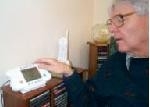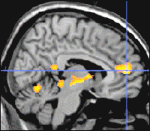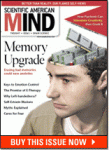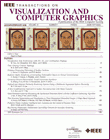Nov 30, 2005
BrainML project
One such extension is provided by the new NIH-supported neuroinformatics initiative of the Society for Neuroscience, which supports the development of expert-derived terminology sets for several areas of neuroscience. Under a cooperative agreement, these term lists will be made available Open Source.
This site provides a complete description of BrainML, and it also serves as a public repository of BrainML models.
23:30 Posted in Research tools | Permalink | Comments (0) | Tags: Positive Technology, research tools
Influence of imagined posture and imagery modality on corticospinal excitability
Behav Brain Res. 2005 Nov 25
Authors: Fourkas AD, Ionta S, Aglioti SM
23:25 Posted in Mental practice & mental simulation | Permalink | Comments (0) | Tags: Positive Technology, mental practice, motor imagery
Nov 29, 2005
11th Annual CyberTherapy Conference
The Interactive Media Institute and the Cyberpsychology Lab of the UQO announce the first call for abstracts for CyberTherapy 11. The submission deadline is February 20th 2006.
Guest speaker: Pierre-Gilles de Gennes, Nobel Prize of Physics in 1991
Tentative title of his talk: Contributions of Physics to Medicine
Preconference Workshops: June 12th, 2006
Conference: June 13th - 15th, 2006, Gatineau (Province of Quebec, Canada)
Cyberarium : June 13th, 2006
Submission and Registration Deadlines: February 20th, 2006
Submission for posters, orals and symposiums.
March 6th, 2006: Authors are informed if their submission has been accepted.
March 30th, 2006: Deadline to submit a full paper (for those interested).
April 30th, 2006: Deadline for early pre-registration (see web site for details)
Early pre-registration: 350 $ (Can), 175 $ (Can) for students.
Pre-registration: 450 $ (Can), 225 $ (Can) for students.
May 20th, 2006: Deadline to register for workshops (75 $ (Can) per workshop).
June 6th, 2006: Deadline for pre-registration (only on-site registration after that date: 500 $ (Can), 275 $ (Can) for students).
Note that abstracts will be published in a regular issue of the journal Cyberpsychology and Behavior and presentations will be available in pdf on the CT11 web site the day after the conference.
More information about the CT11 conference can be found on the Interactive Media Institute website
17:06 Posted in Positive Technology events | Permalink | Comments (0) | Tags: Positive Technology
Nov 28, 2005
Wireless care for dementia patients
Via Medical Informatics Insider
Safe at Home project has evaluated the viability and clinical effectiveness of telecare and assistive technology in supporting the independence of people with dementia.

According to the project's final report, the Safe at Home project has enabled people with dementia to remain independent for longer, receiving the care and support they need in their own homes through the use of assistive technology, and has brought the local agencies in Northamptonshire equivalent savings of over £1.5 million over the 21 months during which research took place.
Emerging from ideas developed from the EU-funded ASTRID project that was led by Northamptonshire County Council, Safe at Home began as a small-scale project in 2000, and an initial evaluation published in 2002 provided evidence that supported a decision to expand the project. A second evaluation of this larger project was undertaken from June 2002 to March 2004, and involved 233 individuals and their carers. The study aimed to assess the reliability of the assistive technology used, the extent to which it supported unpaid carers, the extent to which it supported the independence of people with dementia and the cost effectiveness of the technology.
20:10 Posted in Brain training & cognitive enhancement | Permalink | Comments (0) | Tags: Positive Technology, Cognitive prosthetics
Nominate Positive Technology for the Medical Weblog Award!
Medgadget has announced the second annual Medical Weblog Awards. These awards are designed to honor the very best in the medical blogosphere, as decided by the readers.

The categories for this year's awards will be:
-- Best Medical Weblog
-- Best New Medical Weblog (established in 2005)
-- Best Literary Medical Weblog
-- Best Clinical Sciences Weblog
-- Best Health Policies/Ethics Weblog
-- Best Medical Technologies/Informatics Weblog
Nominations are now accepted here.
This will help the PT community to grow up and gain more visibility.
I remind all readers that Positive Technology is a not-for-profit initiative for disseminating the applications of interactive technology in mental health and well-being.
16:56 Posted in Positive Technology events | Permalink | Comments (0) | Tags: Positive Technology
Disruptive Innovations in Healthcare Conference
The Healthcare Innovation and Convergence Summit (Health IC) focuses on the most disruptive innovations occurring today, showcases the business and convergence opportunities, presents a roadmap for the future, and provides a forum specifically geared towards matching today’s most innovative new companies with investors and developers.
A two-day, four-track conference program of seminars, panels and roundtables covers new science, technology and business approaches in regenerative medicine, innovative patient care, and medical informatics.
More information on the conference website
15:28 Posted in Positive Technology events | Permalink | Comments (0) | Tags: Positive Technology
60 seconds trip
15:00 Posted in Cyberart | Permalink | Comments (0) | Tags: Positive Technology
Nov 26, 2005
EMG Activity in Selected Target Muscles During Imagery Rising on Tiptoes in Healthy Adults and Poststroke Hemiparetic Patients
Authors: Dickstein R, Gazit-Grunwald M, Plax M, Dunsky A, Marcovitz E
The authors sought to gain further knowledge about activation of target muscles during imagery engagement in a motor task. Six hemiparetic patients and 9 healthy participants performed 3 real rises on tiptoes and then, after pausing, 3 imagery rises on tiptoes. Metronome beats guided the rate of rises and descents. Electromyographic (EMG) activity from the medial gastrocnemius and the rectus femoris muscles were monitored bilaterally throughout the performance of both tasks. In 3 healthy participants and 3 individuals with hemiparesis, EMG activity was related to the imagery task in at least 1 of the target muscles. Conversely, in the other participants, motor imagery practice was not accompanied by task-related EMG activity in the monitored muscles. In all cases, the increment in activation level during motor imagery practice was very low in comparison with that of real performance. The findings were not unequivocal; therefore, EMG activity may sometimes, but not always, be recorded during motor imagery practice both in healthy individuals and in poststroke hemiparetic participants. Further research is needed to align motor imagery practice with the objectives of motor rehabilitation.
11:55 Posted in Mental practice & mental simulation | Permalink | Comments (0) | Tags: Positive Technology, mental practice, motor imagery
Nov 23, 2005
CHI 2006 Workshop: Designing for Collective Remembering - Montreal, Canada
Via Usability News
Event Date: 23 April 2006 to 23 April 2006
Venue: Montreal, Canada
Dates: 23 April 2006
We invite position papers for the CHI 2006 Workshop entitled “Designing for Collective Remembering”. While much research has focused on capturing and sharing personal memories, less work has addresses collective memories and their remembrance. When memories relate to significant events impacting on an entire group or community and are shared amongst that group, they become collective. Such memories are usually rich, emotionally charged, better recalled by groups and can enhance the group’s sense of identity.
This one-day workshop will offer an interdisciplinary forum of discussion for practitioners interested in designing technology for collective remembering and academic researchers in fields such as design, HCI, computer science, sociology, anthropology and information science. The workshop will facilitate discussions aimed at the development of a set of guidelines for designing systems for collective remembering. This includes designing for the experience of sharing one’s own memories, and for the experience of enjoying others’ memories.
Submissions in the form of four page position papers describing case studies of fully developed or prototype systems for collective remembering should be sent by December 18 to Corina Sas at c.sas AT lancaster.ac.uk. Theoretical approaches to design challenges for collective memories are also welcomed. Participants will be selected on the basis of the originality of their position paper and contribution to the workshop goals. The workshop will be organised as brief individual presentations, problem-based group learning activities, group presentation and full-group discussion of results.
More info under this link
16:09 Posted in Positive Technology events | Permalink | Comments (0) | Tags: Positive Technology
VR training for safe street crossing of neglect patients
Disabil Rehabil. 2005 Oct 21;27(20):1235-44
Authors: Katz N, Ring H, Naveh Y, Kizony R, Feintuch U, Weiss PL
Abstract. Purpose. The goal of this study was to determine whether non immersive interactive virtual environments are an effective medium for training individuals who suffer from Unilateral Spatial Neglect (USN) as a result of a right hemisphere stroke, and to compare it to a standard computer visual scanning training.Method. Participants included 19 patients with right hemisphere stroke in two groups, 11 in an experimental group were given computer desktop-based Virtual Reality (VR) street crossing training and 8 in a control group who were given computer based visual scanning tasks, both for a total of twelve sessions, 9 hours total, over four weeks. Measures included: 1. Standard USN assessments, paper and pencil and ADL checklist; 2. Test on the VR street program; and 3. Actual street crossing videotaped. Testing was performed pre and post intervention.Results. The VR group achieved on the USN measures results that equaled those achieved by the control group treated with conventional visual scanning tasks. They improved more on the VR test and they did better on some measures of the real street crossing.Conclusions. Despite several limitations in this study the present results support the effectiveness of the VR street program in the treatment of participants with USN, and further development of the program.
16:05 Posted in Cybertherapy | Permalink | Comments (0) | Tags: Positive Technology, virtual reality
Hypnosis can stop Stroop effect
Via Neurodudes
A new experiments by Raz et al., recently published in the Proceedings of the National Academy of Science, found that hypnotic suggestion affects cognitive control by modulating activity in specific brain areas, namely visual areas and the anterior cingulate cortex, which is involved in conflict monitoring.

Raz et al. Hypnotic suggestion reduces conflict in the human brain, Proceedings of the National Academy of Sciences 2005;
Abstract: Many studies have suggested that conflict monitoring involves the anterior cingulate cortex (ACC). We previously showed that a specific hypnotic suggestion reduces involuntary conflict and alters information processing in highly hypnotizable individuals. Hypothesizing that such conflict reduction would be associated with decreased ACC activation, we combined neuroimaging methods to provide high temporal and spatial resolution and studied highly and less-hypnotizable participants both with and without a suggestion to interpret visual words as nonsense strings. Functional MRI data revealed that under posthypnotic suggestion, both ACC and visual areas presented reduced activity in highly hypnotizable persons compared with either no-suggestion or less-hypnotizable controls. Scalp electrode recordings in highly hypnotizable subjects also showed reductions in posterior activation under suggestion, indicating visual system alterations. Our findings illuminate how suggestion affects cognitive control by modulating activity in specific brain areas, including early visual modules, and provide a more scientific account relating the neural effects of suggestion to placebo.
16:00 Posted in Meditation & brain | Permalink | Comments (0) | Tags: Positive Technology, meditation
The Health e-Technologies Initiative
The Health e-Technologies Initiative is a $10.3-million National Program Office of The Robert Wood Johnson Foundation. The program of funded research aims to advance the discovery of scientific knowledge regarding the effectiveness of interactive applications (i.e., Internet, interactive TV and voice response systems, kiosks, personal digital assistants, CD-ROMs, DVDs) for health behavior change and chronic disease management.

Link to the initiative
15:22 Posted in Research institutions & funding opportunities | Permalink | Comments (0) | Tags: Positive Technology
Nov 19, 2005
The Promise of eTherapy

17:35 Posted in Positive Technology events | Permalink | Comments (0) | Tags: Positive Technology, cyberterapy
Job Opening: Research Assistant in the project Augmented Reality & Pervasive Computing Lab
(thanks Regine)
From the Augmented Reality & Pervasive Computing Lab (Universität Graz) web site:
Technische Universität Graz (TUG), Austria, invites applications for open research positions in the project Augmented Reality & Pervasive Computing Lab, aiming at the development of mobile augmented reality, wireless information systems, and ubiquitous computing infrastructures. This program is funded in part by theAustrian Ministry of Science (bm:bwk), the Austrian Science Funds, and the IST program of the EC. More details on the project are given in the summary below. We are looking for a candidate having some or most of the following qualifications:
- University degree, preferably MS (Diplom, DEA, or equivalent) in computer science, mathematics or related field; plus the intent to pursue a PhD at TUG or in collaboration with the candidate's home institute. Alternatively, we are also inviting applications from postdocs who are interested in continuing scientific work. Compensation will be based on qualification.
- Strong interest in research on virtual environments, augmented reality, humancomputer interaction, real-time graphics, and pervasive computing infrastructures. Some background in computer graphics, multimedia or networking is expected.
- Considerable experience with software development methodology and tools, in particular object-oriented programming, C++, OpenGL, Open Inventor, XML, MS Windows, Linux. Prior involvement in research or development projects is a plus.
- Fluency in English, good communication skills and capability of working in teams complete the profile of a successful candidate. Note that knowledge of German is not expected (but this may be your chance to learn it! :-). What do we offer in exchange:
- The opportunity of pursuing a funded PhD/research position in an exciting new field
- A lot of freedom to explore both your scientific and creative interests in the course of your work
- A very good working climate
- A chance to live in the beautiful city of Graz
Project Summary
In our everyday world we are not limited to our computer desktop. Information in the real world is perceived and processed in three dimensions, continuously and in real time. A human-computer interface that can capture these properties will be able to render a new level of services to the user, enabling the use of computers for new application domains and for new user populations. This „anywhere" and „anytime" requirement for pervasive computing cannot be fulfilled with miniature versions of desktop environments, such as provided by the ubiquitous cell phones, nor can it be realized by putting web kiosks around every corner. Therefore, what kind of user interface style can provide these radically different properties for the years to come?
The core of the proposed research is the following thesis: Augmented reality (AR), i. e., enhancing a user‘s perception of the real world with computer generated elements (e. g., explanations), can make working with computers in 3D as productive as the desktop metaphor in 2D. This thesis is motivated by the fact that AR allows to integrate the whole world into the interface – the world essentially becomes the interface. Therefore users are able to leave their physical desktops and computer desktops to interact with their environment and with other users. The AR platform Studierstube lead by the proposer is world-wide unique in its combination of augmented reality, 3D display and groupware elements. The proposed program work will expand the augmented reality platform Studierstube into a pervasive computing environment built on a variety emerging technologies.
Some important building blocks of this of this infrastructure are:
- Wearable computer with 3D augmented reality display
- Wireless spontaneous communication: among worn components, with the environment, with other users, indoors and outdoors
- Exact position tracking indoors and outdoors
- Integration into the environment, e. g., spontaneous usage of situated displays and devices
- Scalable situated multi-user displays based on inexpensive PC clusters and projectors.
A number of promising application areas is selected, for which applications will be developed that try out the new style of interfacing with the computer in practice:
- Navigation and guidance systems
- Tourist information systerms
- Building, campus, and office information systems
- Maintainence and repair support
- Planning, surveying and construction
If you think about applying, send a letter including curriculum vitae and publications list (preferable by email) to: Dr. Dieter Schmalstieg, schmalstieg@icg.tu-graz.ac.at
17:23 Posted in Research institutions & funding opportunities | Permalink | Comments (0) | Tags: Positive Technology
Nov 18, 2005
Gaming for Behavior Change and Performance Enhancement
Via VR-PSYCH List
SUMMIT is holding its 4th Workshop on Games for Behavior Change and Performance Enhancement. Keynote speakers include: Mark & Brenda Wiederhold (San Diego), Barr Taylor (Stanford), Hunter Hoffman (University of Washington), and Mike Zyda (USC). The program includes a visit to the CyberTherapy clinic at The Virtual Reality Medical Center.

From the workshop web site:
Gaming for Behavior Change and Performance Enhancement – a workshop that demonstrates the exciting new possibilities for video games in the health care sector.
This workshop will be of interest to clinicians, scientist, psychologists, as well as educators and game developers.
Mark D. Wiederhold creator of “Cyber therapy,” keynotes the workshop on Sunday evening setting the stage for a full day of talks, interaction and group discussions:
-
Hunter Hoffman- The Originator and Developer of the concept of Virtual Reality for distraction as a pain therapy.
-
Barr Taylor- Developer of Virtual communities for risk reduction in teen eating disorders, smoking prevention and stress reduction in cancer survivors.
-
Michael Zyda- Developer of the wildly popular America’s Army Video Game.
-
Field trip to the unique Virtual Reality Medical Center, a cyber clinic of the future where participants will be introduced to simulators for Behavioral Change and Performance Enhancement.
09:07 Posted in Positive Technology events | Permalink | Comments (0) | Tags: Positive Technology
Nov 17, 2005
Video chat software turns users into live avatars
via the Presence Listserv
Oki Electric Industry Co. Ltd. has developed technology that can add animated faces to instant messaging, networked gaming, and other real-time communications used on mobile phones and PCs. Oki's "FaceCommunicator" software leverages technology similar to the company's face recognition software that recognizes handhelds' owners. The technology supports Linux-based mobile phones.
FaceCommunicator is touted as useful for maintaining privacy and security during first time "face-to-face" communications over video phones, mobile phones, or in IM or chat-room chats on the Internet. In addition, the facial animations let users express emotions that might be hard to express in words, Oki says.
The technology can take advantage of four sources of user input to generate and control its transmitted animated faces - video images from PC or mobile phone cameras; voice; text; and mouse/keyboard commands.
Both the animated face and a background image can be selected by the user to suit the need of the moment. Additionally, certain of the animated faces can move their eyebrows and mouths as though talking, which adds a virtual reality dimension to communications, according to Oki.

Read full article
14:55 Posted in Telepresence & virtual presence | Permalink | Comments (0) | Tags: Positive Technology, social presence
Nov 15, 2005
Meditation affects physical structure of the brain
Via Mind Hacks
A new study published in the journal NeuroReport has found evidence that meditation alters brain patterns. The MRI experiment involved 20 participants with extensive Insight meditation experience. Most of the brain regions identified to be changed through meditation were found in the right hemisphere, which is essential for sustaining attention.
Lazar SW, Kerr CE, Wasserman RH, Gray JR, Greve DN, Treadway MT, McGarvey M, Quinn BT, Dusek JA, Benson H, Rauch SL, Moore CI, Fischl B., Meditation experience is associated with increased cortical thickness. Neuroreport. 2005 Nov 28;16(17):1893-1897.
Abstract. Previous research indicates that long-term meditation practice is associated with altered resting electroencephalogram patterns, suggestive of long lasting changes in brain activity. We hypothesized that meditation practice might also be associated with changes in the brain's physical structure. Magnetic resonance imaging was used to assess cortical thickness in 20 participants with extensive Insight meditation experience, which involves focused attention to internal experiences. Brain regions associated with attention, interoception and sensory processing were thicker in meditation participants than matched controls, including the prefrontal cortex and right anterior insula. Between-group differences in prefrontal cortical thickness were most pronounced in older participants, suggesting that meditation might offset age-related cortical thinning. Finally, the thickness of two regions correlated with meditation experience. These data provide the first structural evidence for experience-dependent cortical plasticity associated with meditation practice.
23:20 Posted in Meditation & brain | Permalink | Comments (0) | Tags: Positive Technology, meditation
Nov 13, 2005
Development of a Virtual Reality System for the Rehabilitation of the Upper Limb After Stroke
Authors: Crosbie J, McDonough S, Lennon S, McNeill M
Virtual reality (VR) provides a three-dimensional computer representation of a real world or imaginary space through which a person can navigate and interact with objects to carry out specific tasks. One novel application of VR technology is in rehabilitation following stroke, particularly of the upper limb. This paper describes the development of a VR system for use in this field. This system gives the user the ability to interact with objects by touching, grasping and moving their upper limb.
21:25 Posted in Cybertherapy | Permalink | Comments (0) | Tags: Positive Technology, virtual reality
Nov 09, 2005
Special issue on haptics, virtual, and augmented reality - IEEE Trans Vis Comput Graph
Authors: Burdea GC, Lin MC, Ribarsky W, Watson B

10:19 Posted in Positive Technology events | Permalink | Comments (0) | Tags: Positive Technology
Real-time 3D human capture system for mixed-reality art and entertainment
Authors: Nguyen TH, Qui TC, Xu K, Cheok AD, Teo SL, Zhou Z, Mallawaarachchi A, Lee SP, Liu W, Teo HS, Thang le N, Li Y, Kato H
A real-time system for capturing humans in 3D and placing them into a mixed reality environment is presented in this paper. The subject is captured by nine cameras surrounding her. Looking through a head-mounted-display with a camera in front pointing at a marker, the user can see the 3D image of this subject overlaid onto a mixed reality scene. The 3D images of the subject viewed from this viewpoint are constructed using a robust and fast shape-from-silhouette algorithm. The paper also presents several techniques to produce good quality and speed up the whole system. The frame rate of our system is around 25 fps using only standard Intel processor-based personal computers. Besides a remote live 3D conferencing and collaborating system, we also describe an application of the system in art and entertainment, named Magic Land, which is a mixed reality environment where captured avatars of human and 3D computer generated virtual animations can form an interactive story and play with each other. This system demonstrates many technologies in human computer interaction: mixed reality, tangible interaction, and 3D communication. The result of the user study not only emphasizes the benefits, but also addresses some issues of these technologies.
10:05 Posted in Augmented/mixed reality | Permalink | Comments (0) | Tags: Positive Technology, Augmented/mixed reality







